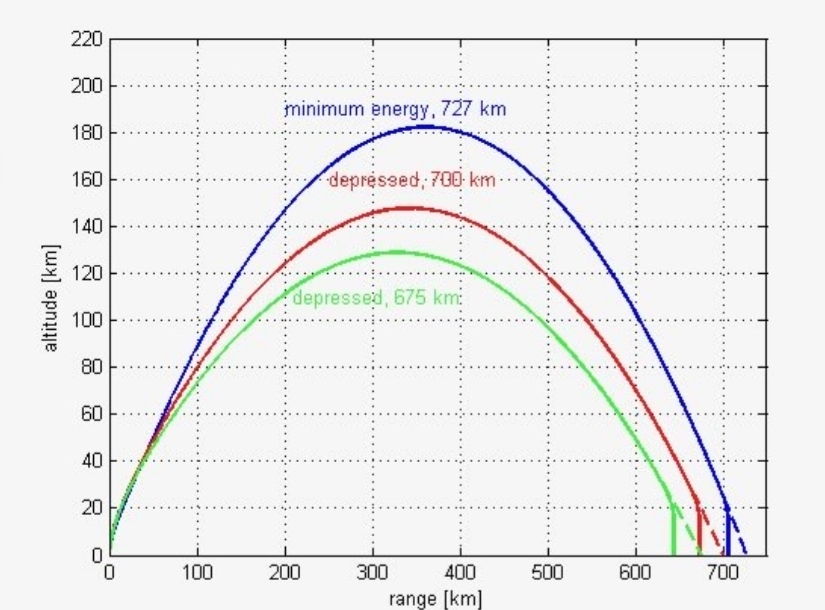‘Massive Improvement’ In Accuracy Of Iran Missiles Over Scud-B

Types and ranges of Iranian missiles
Who would have thought that almost 40 years after Iran and Iraq exchanged volleys of Scud missiles during the Iran-Iraq war, Scud missiles would again be fired from Iran at targets in Iraq
A detailed analysis concludes that at least some of the missiles fired at two bases are indeed modified Scuds and that Iran has succeeded in building missiles that represent a massive improvement over the original Scud-B’s accuracy.
The newer missiles achieved an accuracy of a 10 meter to 100 meter CEP at 700 km. Given the apparent reliability value of the missiles launched to actually hit something (somewhat over 50 percent) and the apparent CEP below 100m, this strike sent a message: Iran can put hundreds of kilos of high explosive on targets within 700km of Iran that are unprotected by anti-missile capabilities.
Footage broadcast on Iranian TV, purportedly of some of the missiles being launched, showed them leaving the ground at an angle which suggests that they were Fateh-110 missiles or variants thereof. This is a solid-propellant missile launched from an inclined launch rail, with a reported range of 300 km. The shortest distance from Al Asad AB to the Iranian border is roughly 280 km, so it would theoretically be in range. Newer variants reportedly have a longer range. Pictures of wreckage were posted on Twitter and show remnants of a missile that fell in the desert near the (aptly named) town of Hīt, to the south-east of Al Asad AB. Figure 1 shows an example. This clearly is a liquid propellant missile, with integral tanks and plumbing for supplying propellant to the engine turbo pump. The pictures offer numerous clues that it is a specific variant of the Scud missile, rather than a variant of the Fateh-110.

Figure 1 Lower part of the missile that landed near Hīt. Original image via Twitter.
Figure 1 shows roughly the lower half of the missile booster, with the bottom end on the left-hand side. The missile is pretty badly mangled, but number 1 marks what appears to be the turbo pump exhaust. The side of the missile shows an inspection hatch, marked by the number 2 in the image. These are features common to Scud variants. Numbers 3 and 4 mark propellant vents or filling openings. The top one appears to have red paint around it and the bottom one yellow paint. On Iranian missiles, yellow denotes fuel and red denotes the oxidizer, so this missile has its fuel tank underneath the oxidizer tank.
The Scud was originally a Soviet missile from the 1950s, with a range of roughly 300km with a 1000kg payload. It uses inhibited fuming red nitric acid as the oxidizer and kerosene as its fuel. These propellants are more energetic than those of the German WW-2 era V-2 ballistic missile and the Scud has integral tanks, but its boost-phase guidance and steering systems are closely related to those of the older missile. Because of that, most Scuds are notoriously inaccurate. A measure of the accuracy is the Circular Error Probable (CEP); if multiple missiles are fired against the same target, the CEP is the radius of the circle around the target that contains the impact points of half of them. For the Soviet Scud-B it is roughly one kilometer at 300km range. Thus ‘classic’ Scuds are accurate enough for city-sized targets. Since small and hardened targets require miss distances of at most several tens of meters, even with 1000 kg of explosives, without accurate guidance a conventionally armed ballistic missile is a rather poor weapon.

Figure 2: Four different Scud variants known to be in Iranian service. The missiles are shown to scale. Oxidizer tanks are red; fuel tanks are marked in yellow.
The Shahab-1 (similar to the DPRK Hwasong-5) is the equivalent of the original Scud-B. The Shahab-2/ Scud-C (similar to the DPRK Hwasong-6) has an increased propellant load and decreased warhead mass, which gives it a range up to 600 km. In 2010 Iran unveiled a new variant, known as the Qiam-1 (Burkan-2H in Yemeni use). Houthi forces have famously launched several of these at targets in Saudi Arabia. It has a number of distinguishing features. It lacks the large stabilizing tailfins, has a smaller so-called triconic re-entry vehicle (RV) similar to those used on Iran’s longer-ranged Ghadr-H missiles and it has considerably longer propellant tanks. Thanks to an investigation of wreckage by a UN Panel of Experts on Yemen of Burkan-2H missiles that landed in Saudi Arabia a lot of information about the missile is known. Its fuel tank is mounted at the bottom, with the oxidizer tank mounted above it. This is different from the Shahab-1 and 2, but matches the wreckage in Iraq. Its oxidizer tank is split into two separate sections; the lower of the two is drained first to ensure that the missile’s center of gravity remains far enough forward to stabilize the flight. The latest Iranian Scud version is the Qiam-2. In October of 2018 it was used in an Iranian strike against ISIS in Muharram in Syria. Photographs are shown in Figure 3.

Figure 3. A Qiam-2 on its launch table (a) and a close-up of the re-entry vehicle of a missile lying on its erector-launcher (b). Original images via Tasnimnews. Note the locations of the red and yellow fuel vents/ filling ports in (a).
The airframe appears identical to that of the Qiam-1, albeit with the addition of small stabilizing fins at the bottom. The re-entry vehicle is different too, with a smaller diameter base than the booster. The difference in diameters is made up by a small tapering section on top of the booster, which is also absent from the Qiam-1.

Figure 4: A view of the bottom of the wreckage, showing fins (marked 1 and 2) and the turbopump exhaust (marked 3). Original image via Twitter.
Figure 4 shows another picture of the bottom end of the wreckage near Hīt, posted by another twitter user and from another angle. Small tailfins are visible near numbers 1 and 2. Number 3 indicates the turbo pump exhaust. Reported coordinates place it some 30 km outside of the Al Asad base. A photograph of the front end of the booster, shown in Figure 5, reveals that it has a small tapering section at the front. This missile clearly is a Qiam-2.

Figure 5: The front end of the missile pointing left. Original image via Twitter.
The most significant feature of the Qiam-2 is that its re-entry vehicle has moveable fins, also visible in Figure 3. This suggests that it can be steered during its terminal flight towards the target, to improve the accuracy. This technology is not completely novel.
During the Cold War, the US Army fielded the Pershing II missile, which had a maneuverable re-entry vehicle (MARV) that was guided using radar terrain correlation (terminal guidance). Reported values for its CEP range from 10-40 m. Several other countries are developing or have developed MARVs, including China (DF-15B) and India (AGNI-2).
In 2017, North Korea also unveiled a variant of the Scud missile with a finned re-entry vehicle. That does have the stabilizing tailfins common to other DPRK Scud variants and its MARV has a different shape from that on the Qiam-2, though, which suggests separate developments. There are no known DPRK equivalents to either the Qiam-1 or the Qiam-2.
That this missile ended up some 30 kilometers outside of the base may suggest that, despite a drive towards more accuracy, it missed its target. However, the MARV separates from the booster just after burnout.
Both will then fly similar ballistic trajectories through space. During the re-entry into the atmosphere the trajectories will start to differ, even for a re-entry vehicle that does not steer aerodynamically.
The re-entry vehicle is aerodynamically stable. The separated booster is not stabilized and such objects usually tumble during re-entry.
The most common final configuration settles on maximum drag (broadside to velocity vector). This will cause it to fall short of the RV impact point, as illustrated in Figure 6.

Figure 6: Simulated trajectories of the Qiam-1. Solid lines represent the trajectories of the booster. The dashed graphs represent the trajectory of the re-entry vehicle.
It shows trajectories that follow from computer simulations of the Qiam-1, with model parameters from my previous open-source study of the Qiam-1, with a 750 kg re-entry vehicle.
On a so-called minimum energy trajectory, for maximum range, the simulated model can fly a distance of 727 km, which is consistent with the 700-800 km range claimed for this missile by Iran. The figure also shows trajectories of the booster, assuming a much larger drag than the RV.
In these simulations, at altitudes of roughly 20km, the aerodynamic drag on the booster becomes so large that it falls almost vertically. For the minimum energy trajectory (maximum range), it impacts 21 km short of the RV impact point.
For targets at shorter ranges than the maximum, a ballistic missile can fly either lofted or shallower (so-called depressed) trajectories. Two examples of such tactically relevant depressed trajectories, for 700 km and 675 km, also appear in Figure 6.
Shallower trajectories have extended travel via the thickest part of the atmosphere, resulting in significant separation between the impact points of the RV and the booster.
Simulations show an expected booster shortfall of 27 km (at 700 km ground range) and 31 km (at 675 km ground range). The slowdown of the booster leaves it falling at terminal velocity and subject to high altitude winds for hundreds of seconds. Such ‘windage’ may further increase the shortfall and/or deviation from the RV ground track.
Finally, by design, the MARV performs terminal accuracy maneuvers via aerodynamic controls deviating from the ballistic trajectory. Therefore the location of the missile carcass does not indicate whether or not the RV struck its target, but it is pretty much where one would expect it to be if the missile flew a 600-700 km trajectory from Iran towards Al Asad.
Without knowledge of the Iranian targeting plan, it is impossible to precisely determine the accuracy of the attack from post-strike images of the base. At least five buildings have been substantially damaged, but other missiles struck the aircraft ramp area and the edges of taxiways. Assuming that the missiles that struck the buildings were indeed aimed at those particular buildings, the CEP is on the order of ten to several tens of meters, given that the buildings themselves have substantial footprints.
The improved accuracy is partially offset by the relatively small impact explosive areas (crater/blast radius) that show the modest Houthi warhead size is an option also available to the Iranian missile forces.




